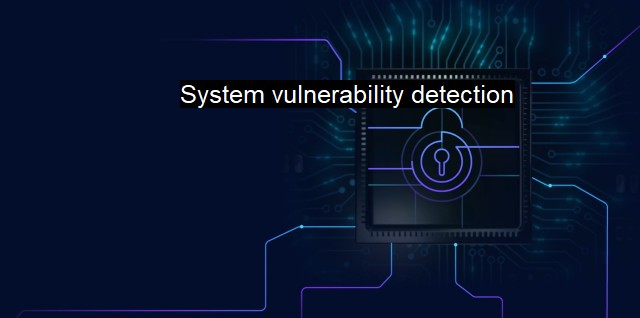What is System vulnerability detection?
The Importance of System Vulnerability Detection in Cybersecurity: Active vs. Passive Approaches for Effective Risk Assessment and Remediation
System vulnerability detection can be recognized as an integral part of maintaining the security and integrity of computer systems. These are methods used to identify, classify, and deal with the weak points in a system or network—areas that could potentially be exploited by adversaries to gain unauthorized access or cause harm.In the cyber world, system vulnerabilities encompass a broad spectrum, ranging from weak configurations, faulty architecture, insecure data communications, or design flaws. These can be inherent in various components such as the operating system, network infrastructure, or application software. Detecting these vulnerabilities can help in taking appropriate preemptive mitigation measures, thus thwarting any attempts at unauthorized access to sensitive data or potential system impairment.
There are various techniques employed for system vulnerability detection. The most commonly used tools and techniques include vulnerability scanners, intrusion detection systems (IDS), intrusion prevention systems (IPS), and antivirus software.
Vulnerability scanners are software applications designed to assess networks, computers, or applications for known weaknesses. They automate the process of checking systems against known vulnerability signatures, producing a report of the potential vulnerability points.
Intrusion detection systems are designed to monitor network traffic, looking for suspicious activity and potential threats. Upon detection of a potential security threat, IDS alerts the system or network administrator. Similarly, an intrusion prevention system is a network security function that scrutinizes network traffic flows to detect and prevent vulnerability exploits by logging them and reporting them.
Antivirus software is another popular form of system vulnerability detection. It guards the system against malware, such as viruses, worms, trojans, adware, or spyware. It identifies, quarantines, and eliminates these threats by comparing a database of known malware signatures to files on a computer to determine if they’re infected or not.
Usually, system vulnerability detection proceeds in phases. First, the system or network is mapped, identifying all hosts, applications, and services. Then the software scans the system, looking for potential vulnerabilities that could be manipulated by an attacker, as manual examination of complex systems is incredibly time-intensive and not practical.
The effectiveness of system vulnerability detection relies on the comprehensiveness and impact of the countermeasures employed elucidated from the vulnerability report. An informative vulnerability report would detail the locations of detected vulnerabilities, their expected impacts, and suggested solutions. It guides IT professionals in prioritizing their responses, by indicating which vulnerabilities are most critical and require immediate attention.
Beyond just identification, patch management plays a crucial role in mitigating system vulnerabilities. Upon discovery of a vulnerability, software authors will typically publish patches or updates, designed to close the security hole. Timely implementation of these patches prevents attackers from exploiting the loophole.
System vulnerability detection isn't a one-off process. It requires the continuous monitoring and updating of systems due to the ever-evolving nature of threats in cyber-space. Cybersecurity experts recommend that system vulnerability assessments be performed regularly. Similarly, antivirus software should be kept current, with regular updates for newly identified threats.
System vulnerability detection is an essential practice in the world of cybersecurity. It aids in identifying flaws that could else be exploited, maintaining the integrity and security of systems, and protecting sensitive data. With ever-evolving cyber threats, regular system vulnerability detection combined with aggressive update and patch management, are non-negotiable security measures that must be practiced consistently. Antivirus software and vulnerability scanners play an important role in this practice by identifying, isolating, and eliminating malware threats.

System vulnerability detection FAQs
What is system vulnerability detection and why is it important for cybersecurity?
System vulnerability detection is the process of identifying weaknesses in computer systems or networks that attackers can exploit to gain unauthorized access or damage the system. It is crucial for cybersecurity because it helps prevent security breaches and minimize the risk of attacks.How does system vulnerability detection work?
System vulnerability detection works by scanning the system or network for vulnerabilities and weaknesses. This can be done manually or using automated tools such as antivirus software. The scanner checks for vulnerabilities such as outdated software, weak passwords, and unsecured network connections. Once vulnerabilities are detected, steps can be taken to address them and minimize the risk of attacks.What are some examples of vulnerabilities that system vulnerability detection can detect?
Some examples of vulnerabilities that system vulnerability detection can detect include software vulnerabilities, configuration errors, weak passwords, and unsecured network connections. Other examples may include outdated antivirus software, missing security patches, and open ports.Can system vulnerability detection completely prevent cyber attacks?
While system vulnerability detection is an important part of cybersecurity, it cannot completely prevent cyber attacks. Attackers are constantly finding new ways to exploit vulnerabilities and bypass security measures. However, by regularly scanning for vulnerabilities and addressing them promptly, the risk of attacks can be minimized and the impact of any successful attacks can be reduced.| | A | | | B | | | C | | | D | | | E | | | F | | | G | | | H | | | I | | | J | | | K | | | L | | | M | |
| | N | | | O | | | P | | | Q | | | R | | | S | | | T | | | U | | | V | | | W | | | X | | | Y | | | Z | |
| | 1 | | | 2 | | | 3 | | | 4 | | | 7 | | | 8 | | |||||||